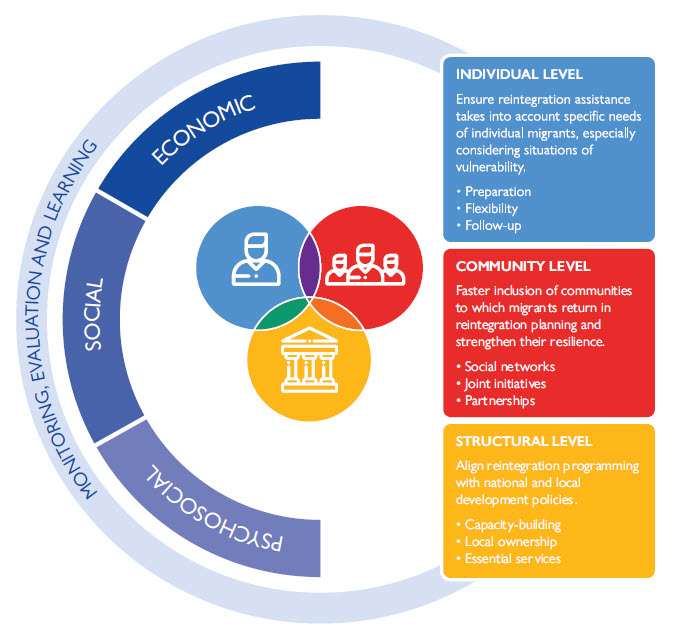With the aim of achieving sustainable reintegration as it is defined above, and based on its years of experience, IOM conceptualised its integrated approach to reintegration in 2017. The basic premise of this approach is that the complex, multidimensional process of reintegration requires a holistic and needs-based approach. Such an approach takes into consideration the various factors that can affect reintegration, including economic, social and psychosocial dimensions. It responds to the needs of individual returnees and the communities to which they return in a mutually beneficial way, while also addressing the structural factors at play.
To meet these objectives, IOM’s integrated approach deploys three levels of support:
- The individual level has initiatives to address the specific needs and vulnerabilities of returnees and returning family members;
- The community level encompasses initiatives that respond to the needs, vulnerabilities and concerns of communities to which migrants return, including returnee families and the non-migrant population.
- Structural level initiatives promote good governance of migration through engagement with local and national authorities and stakeholders and supports continuity of assistance through adequate local public services.
Within each of these levels, IOM’s integrated approach addresses three dimensions of reintegration:
- The economic dimension covers aspects of reintegration that contributes to re-entering the economic life and sustained livelihoods.
- The social dimension addresses returning migrants’ access to public services and infrastructure in their countries of origin, including access to health, education, housing, justice and social protection schemes.
- The psychosocial dimension encompasses the reinsertion of returning migrants into personal support networks (friends, relatives, neighbours) and civil society structures (associations, self-help groups, other organizations and civic life generally). This also includes the re-engagement with the values, ways of living, language, moral principles and traditions of the country of origin’s society.
Note that these levels and dimensions are not clear-cut, nor are they mutually exclusive. They overlap and are interconnected by their nature. The economic, social and psychosocial dimensions can influence one another, sometimes on different levels. For example, a community’s attitude towards returnees can affect a returnee’s physical and mental health which in turn can affect their livelihood and economic opportunities. Ensuring that a reintegration programme addresses the full range of factors that affects reintegration is more important than classifying specific activities for these categories.
The diagram below provides a visual summary of the integrated approach to reintegration.
INTEGRATED APPROACH TO REINTEGRATION

An integrated approach to reintegration should also address cross-cutting issues such as promoting migrant rights, gender equality, partnerships and cooperation as well as improve data collection and monitoring and evaluation of reintegration. Such an approach typically falls under the responsibility of a variety of different stakeholders, whether national and local governments in host countries and countries of origin, international non-governmental organizations (INGOs), non-governmental organizations (NGOs) and civil society organizations (CSOs) that have various roles in the reintegration interventions.